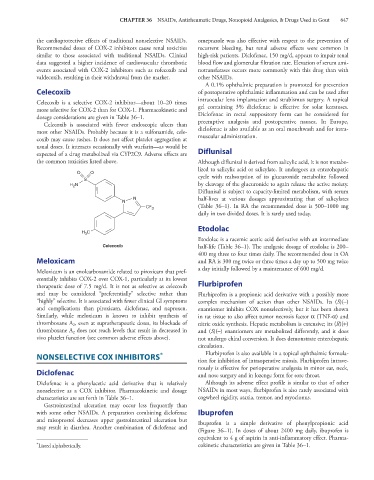Page 661 - Basic _ Clinical Pharmacology ( PDFDrive )
P. 661
CHAPTER 36 NSAIDs, Antirheumatic Drugs, Nonopioid Analgesics, & Drugs Used in Gout 647
the cardioprotective effects of traditional nonselective NSAIDs. omeprazole was also effective with respect to the prevention of
Recommended doses of COX-2 inhibitors cause renal toxicities recurrent bleeding, but renal adverse effects were common in
similar to those associated with traditional NSAIDs. Clinical high-risk patients. Diclofenac, 150 mg/d, appears to impair renal
data suggested a higher incidence of cardiovascular thrombotic blood flow and glomerular filtration rate. Elevation of serum ami-
events associated with COX-2 inhibitors such as rofecoxib and notransferases occurs more commonly with this drug than with
valdecoxib, resulting in their withdrawal from the market. other NSAIDs.
A 0.1% ophthalmic preparation is promoted for prevention
Celecoxib of postoperative ophthalmic inflammation and can be used after
intraocular lens implantation and strabismus surgery. A topical
Celecoxib is a selective COX-2 inhibitor—about 10–20 times
more selective for COX-2 than for COX-1. Pharmacokinetic and gel containing 3% diclofenac is effective for solar keratoses.
dosage considerations are given in Table 36–1. Diclofenac in rectal suppository form can be considered for
Celecoxib is associated with fewer endoscopic ulcers than preemptive analgesia and postoperative nausea. In Europe,
most other NSAIDs. Probably because it is a sulfonamide, cele- diclofenac is also available as an oral mouthwash and for intra-
coxib may cause rashes. It does not affect platelet aggregation at muscular administration.
usual doses. It interacts occasionally with warfarin—as would be
expected of a drug metabolized via CYP2C9. Adverse effects are Diflunisal
the common toxicities listed above. Although diflunisal is derived from salicylic acid, it is not metabo-
lized to salicylic acid or salicylate. It undergoes an enterohepatic
O O cycle with reabsorption of its glucuronide metabolite followed
S
H N by cleavage of the glucuronide to again release the active moiety.
2
Diflunisal is subject to capacity-limited metabolism, with serum
N half-lives at various dosages approximating that of salicylates
N
CF 3 (Table 36–1). In RA the recommended dose is 500–1000 mg
daily in two divided doses. It is rarely used today.
Etodolac
H C
3
Etodolac is a racemic acetic acid derivative with an intermediate
Celecoxib half-life (Table 36–1). The analgesic dosage of etodolac is 200–
400 mg three to four times daily. The recommended dose in OA
Meloxicam and RA is 300 mg twice or three times a day up to 500 mg twice
a day initially followed by a maintenance of 600 mg/d.
Meloxicam is an enolcarboxamide related to piroxicam that pref-
erentially inhibits COX-2 over COX-1, particularly at its lowest
therapeutic dose of 7.5 mg/d. It is not as selective as celecoxib Flurbiprofen
and may be considered “preferentially” selective rather than Flurbiprofen is a propionic acid derivative with a possibly more
“highly” selective. It is associated with fewer clinical GI symptoms complex mechanism of action than other NSAIDs. Its (S)(–)
and complications than piroxicam, diclofenac, and naproxen. enantiomer inhibits COX nonselectively, but it has been shown
Similarly, while meloxicam is known to inhibit synthesis of in rat tissue to also affect tumor necrosis factor α (TNF-α) and
thromboxane A , even at supratherapeutic doses, its blockade of nitric oxide synthesis. Hepatic metabolism is extensive; its (R)(+)
2
thromboxane A does not reach levels that result in decreased in and (S)(–) enantiomers are metabolized differently, and it does
2
vivo platelet function (see common adverse effects above). not undergo chiral conversion. It does demonstrate enterohepatic
circulation.
Flurbiprofen is also available in a topical ophthalmic formula-
NONSELECTIVE COX INHIBITORS * tion for inhibition of intraoperative miosis. Flurbiprofen intrave-
nously is effective for perioperative analgesia in minor ear, neck,
Diclofenac and nose surgery and in lozenge form for sore throat.
Diclofenac is a phenylacetic acid derivative that is relatively Although its adverse effect profile is similar to that of other
nonselective as a COX inhibitor. Pharmacokinetic and dosage NSAIDs in most ways, flurbiprofen is also rarely associated with
characteristics are set forth in Table 36–1. cogwheel rigidity, ataxia, tremor, and myoclonus.
Gastrointestinal ulceration may occur less frequently than
with some other NSAIDs. A preparation combining diclofenac Ibuprofen
and misoprostol decreases upper gastrointestinal ulceration but Ibuprofen is a simple derivative of phenylpropionic acid
may result in diarrhea. Another combination of diclofenac and
(Figure 36–1). In doses of about 2400 mg daily, ibuprofen is
equivalent to 4 g of aspirin in anti-inflammatory effect. Pharma-
* cokinetic characteristics are given in Table 36–1.
Listed alphabetically.

